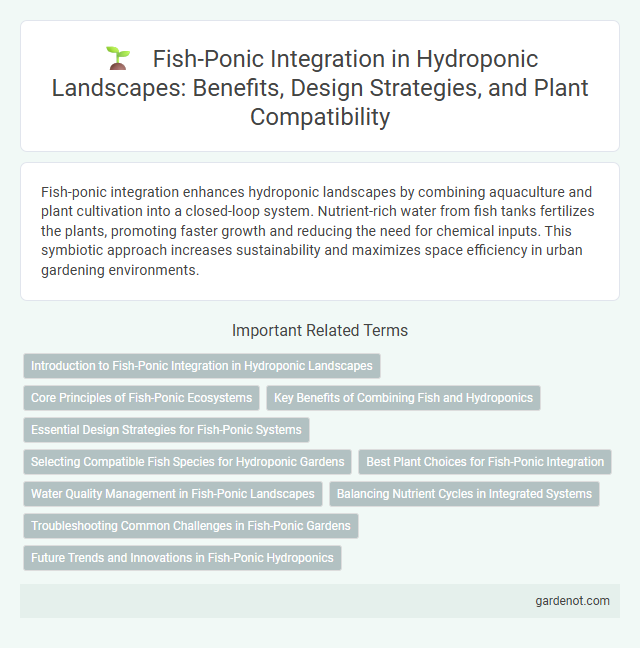Fish-ponic integration enhances hydroponic landscapes by combining aquaculture and plant cultivation into a closed-loop system. Nutrient-rich water from fish tanks fertilizes the plants, promoting faster growth and reducing the need for chemical inputs. This symbiotic approach increases sustainability and maximizes space efficiency in urban gardening environments.
Introduction to Fish-Ponic Integration in Hydroponic Landscapes
Fish-ponic integration combines aquaculture and hydroponics to create a symbiotic ecosystem where fish waste provides essential nutrients for plant growth, enhancing resource efficiency. This sustainable approach reduces water usage by recycling nutrient-rich water from fish tanks directly to hydroponic plants, promoting healthier crops with minimal chemical inputs. Implementing fish-ponic systems in hydroponic landscapes supports biodiversity, increases yield, and fosters eco-friendly urban agriculture.
Core Principles of Fish-Ponic Ecosystems
Fish-ponic ecosystems integrate aquaculture and hydroponics by creating a symbiotic environment where fish waste provides essential nutrients for plant growth. Key principles include maintaining balanced nutrient cycles, optimizing water quality, and ensuring proper oxygenation to support both aquatic life and plant health. This closed-loop system enhances resource efficiency and promotes sustainable, soil-less agriculture.
Key Benefits of Combining Fish and Hydroponics
Fish-ponic integration combines aquaculture with hydroponic systems, optimizing nutrient cycling by using fish waste as a natural fertilizer for plants. This symbiotic approach reduces water consumption by up to 90% compared to traditional agriculture and enhances plant growth rates through continuous nutrient availability. Benefits include improved resource efficiency, reduced environmental impact, and increased production yields in sustainable urban farming.
Essential Design Strategies for Fish-Ponic Systems
Essential design strategies for fish-ponic systems include maintaining optimal water quality parameters such as pH between 6.8 and 7.2, temperature ranging from 20 to 28degC, and dissolved oxygen levels above 5 mg/L to support both fish health and plant growth. Integrating biofilters and mechanical filtration ensures efficient nutrient recycling and waste removal, preventing toxic ammonia accumulation while promoting beneficial bacteria growth. Strategic tank placement, proper aeration, and synchronized feeding schedules optimize nutrient availability and balance within the aquaponic environment, enhancing productivity and system sustainability.
Selecting Compatible Fish Species for Hydroponic Gardens
Selecting compatible fish species for fish-ponic integration in hydroponic gardens is crucial for maintaining a balanced ecosystem and optimizing nutrient cycles. Tilapia, koi, and goldfish are popular choices due to their hardiness, tolerance to varying water conditions, and efficient waste production that supports plant growth. Understanding species-specific needs such as temperature range, oxygen levels, and dietary requirements ensures sustainable fish health and enhances overall hydroponic system productivity.
Best Plant Choices for Fish-Ponic Integration
Optimal plant choices for fish-ponic integration include leafy greens like lettuce, spinach, and kale due to their rapid nutrient uptake and compatibility with aquaponic nutrient cycles. Herbs such as basil, mint, and cilantro thrive in fish-ponic systems, benefiting from consistent nutrient-rich water while improving system biodiversity. Fruiting plants like tomatoes and cucumbers also perform well when paired with robust biofiltration to maintain water quality in fish-ponic environments.
Water Quality Management in Fish-Ponic Landscapes
Effective water quality management in fish-ponic landscapes involves maintaining optimal levels of dissolved oxygen, pH, ammonia, and nitrate to support both plant and fish health. Continuous monitoring systems and biofiltration techniques are crucial for preventing toxic buildup and promoting nutrient recycling within the integrated aquaponic system. Proper aeration and regular water exchanges enhance ecosystem stability, ensuring sustainable productivity in hydroponic and aquaculture components.
Balancing Nutrient Cycles in Integrated Systems
Fish-ponic integration in hydroponic landscapes enhances nutrient cycling by utilizing fish waste as a natural fertilizer for plants, promoting a sustainable and efficient ecosystem. This method maintains balanced nutrient levels through biofiltration processes where beneficial bacteria convert fish excretions into plant-available forms like nitrates and ammonium. Optimizing water quality and nutrient concentration ensures healthy growth for both fish and plants, reducing the need for synthetic fertilizers and supporting environmental sustainability.
Troubleshooting Common Challenges in Fish-Ponic Gardens
Fish-ponic integration in hydroponic landscapes often faces challenges such as water quality imbalances, nutrient deficiencies, and fish health issues. Monitoring pH levels, ammonia concentrations, and oxygenation is essential to prevent toxic buildup and ensure optimal growth conditions for both plants and fish. Regular system checks, biofiltration optimization, and timely adjustments can effectively resolve common problems in fish-ponic gardens.
Future Trends and Innovations in Fish-Ponic Hydroponics
Fish-ponic hydroponics integrates aquaculture and soilless plant cultivation, driving advancements in sustainable food production. Emerging trends include automation with AI-powered systems for optimizing nutrient cycling and water quality, enhancing yield efficiency and resource conservation. Innovations like biofloc technology and sensor-driven real-time monitoring are revolutionizing fish-plant symbiosis, fostering scalable and eco-friendly urban agriculture solutions.
Fish-ponic integration Infographic

 gardenot.com
gardenot.com